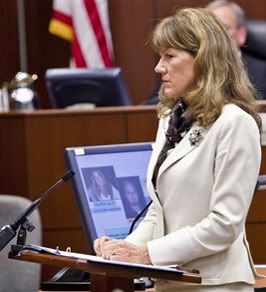
Many people are asking me about the details of James Arthur Ray on the day he was convicted, June 22, 2011.
As soon as the last "guilty" verdict was read, Prosecutor Sheila Polk asked that Ray be taken into custody immediately,
 but she did not prevail. James Ray was not cuffed and he left the courthouse on his own power. However, he did not leave through the front doors like everyone else. He successfully gave the slip to this crowd of reporters waiting for him outside.
but she did not prevail. James Ray was not cuffed and he left the courthouse on his own power. However, he did not leave through the front doors like everyone else. He successfully gave the slip to this crowd of reporters waiting for him outside.I was sitting behind him, so those watching on TV had a better view of his face, but his reaction was overall subtle. No outburst, no sinking of the head or expressive gesture. However, real courtrooms give a measure of suspense you don't get on Perry Mason. The clerk reads out a very long sentence which feels very much like "We the jury of Yavapai County in the state of Arizona in the Western Hemisphere in this, the 21st century which started 11 years ago, having considered the crime of..." You get the picture. It's a long sentence before you hear the words you're interested in. And on Wednesday, June 22, the first words that James Ray could have possibly been interested in that he heard were "Not Guilty."
Luis Li, his lead attorney, immediately reached for his client's shoulder in triumph.
But the long sentence wasn't over. Soon came the real truth and that was that James Ray had been found guilty of... Negligent Homicide. In all three cases.
So Li's hand stayed on his shoulder but now it was for comfort and support.
Sitting behind Ray was his family, his parents and his brother, and behind them, one of the attorney's sons had come to watch him work on a big trial of national interest.
Afterward, Sheila Polk answered questions about the procedure upcoming, but she was very careful to give responses in general about the law, not give any opinions about the verdict.
Defense attorney Truc Do wasn't having any of it. That's her striding across the parking lot, a tiny figure avoiding a big crowd.
Next week her client faces Sheila Polk's aggravation case. This is where the prosecutor puts on witnesses to convince the jury the crime was committed under aggravated circumstances. The jury does not decide the sentence, they do vote on the aggravators. It's like a mini-trial. If they find aggravators, the judge applies enhanced sentencing and it's unlikely Ray will escape jail time. The sentencing comes at a later date, which is as yet undetermined.
The jury was out for less than ten hours. It's difficult to determine exactly how many hours they deliberated because, unlike other trials I've been to, they are allowed to deliberate during lunch if they wish. Since they are still empaneled, we can't ask them if they did. But after a four month trial, with a highly unusual set of facts, less than ten hours seems quite remarkably short to me. I'm guessing most of the deliberation was about whether to apply Reckless Manslaughter or Negligent Homicide and very little discussion about acquittal altogether.
Anybody want to know anything specific? Let me know, I'll look for your answer next week when once again, I'll sit a few feet away from Mr. James Arthur Ray.




